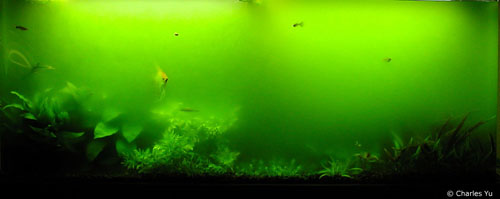Algae – Green Water & Black Brush
February 25th, 2008At the last GWAPA meeting, I gave a presentation called Algae in the Planted Aquarium. While preparing for the presentation, I had to gather a lot of information from a number of different sources on the Internet. I’ve decided to declare this week Algae Week, and share that gathered information by posting about two types of algae each day. By the end of the week, I’ll have covered the most common types of algae encountered, along with suggestions on how to cure your tank. So off we go…
Green Water (Euglaena)

Green water is free floating single-celled euglenoid protists. It contains chlorophyll a and b, plus carotenoids, giving them their green coloration, but they are not plants. With over 40 genera of Euglenoids and over 1000 species, this form of algae is one of the most abundant forms of life on the planet, and is an essential part of the food chain. Unfortunately, aquarists don’t want it in their tanks.
Cause:
- Initial Setup – Usually present shortly after an aquarium is initially setup, prior to the full establishment of the microorganisms (free-swimming plankton that feed upon it).
- Nutrient Imbalance – Strive for the following nutrient levels: N (10-20ppm), P (0.5-2ppm), K (10-20ppm), Ca (10-30ppm), Mg (2-5ppm), Fe (.1ppm).
- Medication – if the medicine affects the biofilter of the tank.
Cure :
There are a number of cures for green water:
- Blackout – leave the lights out, and block out any ambient light from the tank for 5 days. Your plants have reserves that the algae does not, so they will survive, but may look a little ratty for a week or so.
- Diatom/Micron Filter – fine particle filters can clear the water.
- UV Sterilizer – zaps the algae with ultraviolet light, clearing the water. Some reports say that UV light also affects nutrients in the water column.
- Flocculants – Clumps small particles together, allowing your mechanical filtration to remove them from the water. i.e. AquaClear
- Daphnia – Placed in a breeder net, the daphia will consume the algae.
- Small Water Changes – do small (5-10%) water changes, every day until clear.
Notes:
- Avoid large water changes, as that prevents microorganisms from establishing themselves.
- In addition to the cures, make sure to identify and eliminate the source of the problem, or it may return.
Black Brush/Beard (Rhodophyta)

Black brush, or BBA, algae can be one of a number of specific genera of “red” algae in the Rhodophyta family. Most of the algae in this family are actually marine, but a few freshwater species exist that particularly target our planted aquariums. This algae may be black, brown, red, or green in coloration, and can quickly coat your plants and hardscape if not kept in check.
Cause:
- Nutrient Imbalance – potentially excess N, P, Fe. Strive for the following nutrient levels: N (10-20ppm), P (0.5-2ppm), K (10-20ppm), Ca (10-30ppm), Mg (2-5ppm), Fe (.1ppm).
- Low pH – Neil Frank observes that African Rift tanks never have BBA. It’s believed that BBA thrives in acidic environments, which is unfortunately what most plants prefer.
Cure:
- Increase CO2 – This will stimulate plant growth, which should help the plants out-compete the algae for resources.
- Excel/H202 treatment – Use a syringe to spot treat problem areas. Then manually remove when BBA turns grey/white.
- Manual removal – Use toothbrush to remove as much as possible.
- Bleach treatment – Dip affected hardscape items/hardy plants in a bleach/water solution using a 1:20 ratio of bleach to water. Before putting them back into the tank, make sure the item is free of bleach odor.
- Maintain proper water change/dosing schedule – weekly / bi-weekly changes.
- Algae Crew – Siamese Algae Eaters (SAE) and Amano shrimp are known to eat this algae.
- Copper (not recommended) – There are commercial algaecides containing copper that will kill BBA, but they will mostly likely also kill your plants.
Sources:
Aquatic Plant Central – Algae Finder
AquaticScape
The Skeptical Aquarist
February 25th, 2008 at 8:19 am
I don’t know if I’ve just been lucky or what because I’ve never had an algea problem. (I hope I didn’t just jinx myself). Does the green water algea have an odor? It looks scary! The beard algea actually looks kinda cool, but then I don’t want to double jinx myself:)
February 25th, 2008 at 9:06 am
I don’t recall the green water having an odor when I had it, but it’s been some time, and I honestly don’t remember. You can commonly see the beard algae on sponge filters in your local fish store. (One of the reasons not to dump the fish and water straight into your tank.)
February 26th, 2008 at 10:48 am
I thought I had a good bacteria setup, then I changed the charcoal at the same time some food that had been crushed into powder had been added (don’t ask 🙂 The water got real clear for a day(due to the charcoal I guess) then the next day got the green algea bloom.
Will try the 5-10% daily water changes.
February 26th, 2008 at 10:59 am
Aquaman, your problem is probably related to the extra food that was added. The charcoal probably did help polish the water for a bit, but that quickly loses its effectiveness. You may also try leaving the lights turned off for the next 4-5 days, and could even stop feeding the fish for that time period, to avoid adding any more stimulus to the algae. Your fish should be fine.